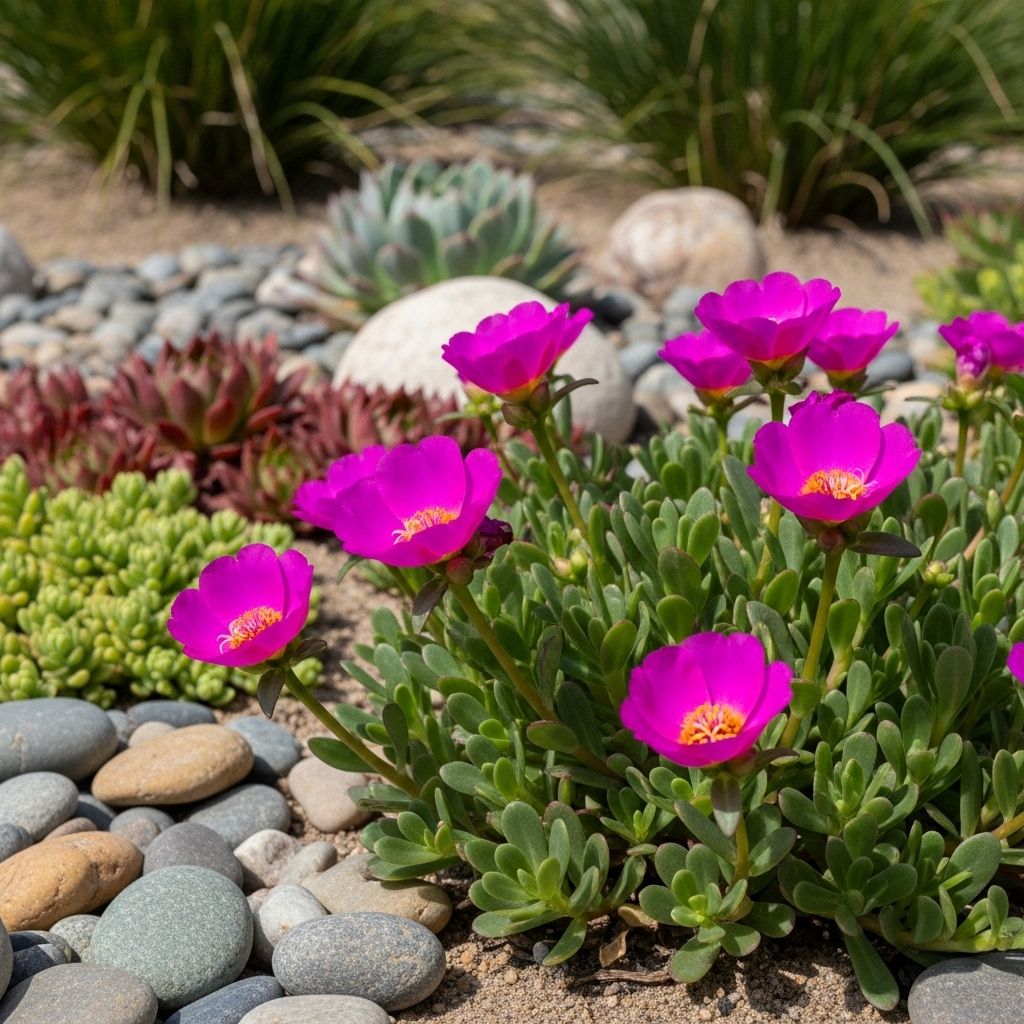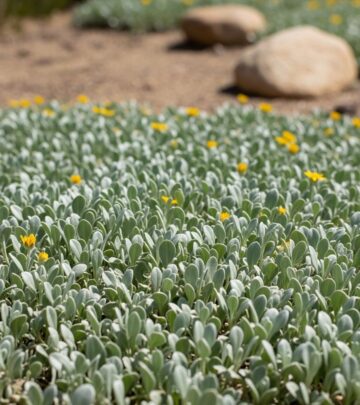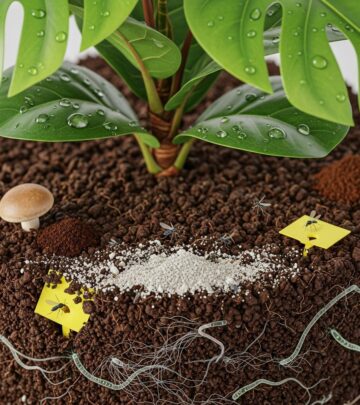Rock Purslane Care: 7 Steps To A Colorful Low-Water Garden
Rock Purslane is a showstopping, low-maintenance succulent that blooms for months and thrives in tough garden spots.

Image: HearthJunction Design Team
Gardening 101: Rock Purslane (Calandrinia spectabilis)
Few plants match the stunning vibrance and resilience of rock purslane (Calandrinia spectabilis, syn. Cistanthe grandiflora). Native to the arid hills of Chile, rock purslane is a succulent that shines in drought-prone gardens with its long-lasting magenta blooms and carefree personality. Whether you have a sunbaked yard, an unruly patch that needs color, or a modern container display, this succulent delivers bold color and satisfaction—no green thumb required.
What Is Rock Purslane?
Rock purslane is a perennial succulent, renowned for its soft grey-green foliage and luminous purple-pink poppy-like flowers. Grown for both its ornamental beauty and its rugged demeanor, this plant forms weed-suppressing mounds, making it a favorite for water-wise gardens.
- Botanical Names: Calandrinia spectabilis, Cistanthe grandiflora
- Common Names: Rock purslane
- Origin: Chile
- Plant Type: Succulent perennial
Why Grow Rock Purslane?
Rock purslane is a garden solution for anyone seeking:
- Unthirsty and undemanding care: It thrives on minimal water and attention.
- Brilliant, long-lasting blooms: Its flowers, likened to magenta poppies or silk petals, appear almost continuously during warm months.
- Weed suppression: Its dense low mounds smother competing weeds.
- Low maintenance: Forgetful waterers and garden novices find this plant forgivable and rewarding.
- Design versatility: Equally at home in rock gardens, xeriscapes, borders, and containers.
Plant Profile: Growth Habit and Characteristics
- Height & Spread: Grows quickly to about 12–18 inches tall, spreading 3–4 feet wide.
- Foliage: Grey-green, plump, and succulent, forming a soft cushion or mound.
- Flowers: 1.5 to 2 inch wide bright magenta blooms on thin stems above the foliage; clusters rebloom for months.
- Bloom Season: Spring through fall (often almost continual in mild climates).
- Hardiness: USDA zones 8–11; tolerates temperatures as low as 15–20°F.
- Habit: Clumping, weed-suppressing groundcover that can expand rapidly in ideal conditions.
How to Grow and Care for Rock Purslane
Keep It Alive: Simple Steps
- Light: Prefers full sun but can handle partial sun. Afternoon shade prevents sunburn in very hot climates.
- Soil: Requires well-draining soil. Amend with perlite, pumice, or small lava rocks if your soil is heavy or clay-rich.
- Water: Drought-tolerant once established. Water deeply but infrequently—weekly in intense heat, less in cool months. Avoid soggy roots!
- Feeding: Add compost in spring for a bloom boost.
- Mulching: Surround with gravel or small stones to highlight foliage and improve drainage.
- Pruning: Cut stems back to about 6 inches in late winter to refresh growth and shape.
- Maintenance: Remove spent flower stems when blooms are finished, but avoid excessive deadheading as many stems rebloom.
Planting Instructions
- Location: Choose a spot with plenty of sun and excellent drainage. Raised beds, rocky slopes, and sandy soils are perfect.
- Soil Prep: If the soil is heavy, dig in perlite or pumice—aim for 20–30% of the soil mix for ideal aeration.
- Spacing: Give plants about 3–4 feet of space, as they expand quickly.
- Water In: Water thoroughly after planting, then withhold water until the top inch of soil dries.
Design Ideas: Where to Use Rock Purslane
- Modern Landscapes: Dramatic color and sculptural foliage make it ideal for minimalist or contemporary gardens.
- Rock Gardens & Slopes: Spreads to cover awkward hillsides, preventing erosion and outcompeting weeds.
- Xeriscapes: Works in low-water gardens with agaves, yuccas, and ornamental grasses.
- Containers: Bold enough for solo planting in large pots, or as a colorful spiller with other succulents.
- Pollinator Attractor: Flowers draw bees and butterflies for months.
Propagation: How to Multiply Your Rock Purslane
Rock purslane is as easy to propagate as it is to grow.
- From Cuttings: Cut a 3-node stem section. Let it air dry for a few days so the cut end calluses (prevents rot). Plant in well-draining soil and water sparingly until rooted.
- Division: Older clumps with multiple rosettes can be separated and replanted in new areas.
With the right conditions, new plants can bloom within 6 months of rooting!
Rock Purslane vs. Common Purslane: Key Differences
| Feature | Rock Purslane (Calandrinia spectabilis) | Common Purslane (Portulaca oleracea) |
|---|---|---|
| Bloom Color | Bright magenta | Yellow or pink, less vibrant |
| Growth Habit | Perennial, forms mounds | Annual, mat-forming |
| Edibility | Ornamental only | Edible leaves and stems |
| Soil Needs | Well-draining, dry | Tolerates diverse soils |
Common Problems & Solutions
- Overwatering: Roots rot quickly if soil stays soggy. Use a cactus/succulent soil for containers and avoid wet feet.
- Sunburn: In extremely hot climates, provide light afternoon shade to prevent scorched leaves.
- Legginess: As plants age, stems may elongate and look sparse. Cut back hard in late winter to encourage fresh compact growth. Replace old plants every few years if needed.
Rock Purslane Through the Seasons
- Spring: Start watering and feeding as new growth appears. Watch for prolific flowering.
- Summer: Enjoy the main bloom period. Water only during heat waves or extended drought.
- Autumn: Flowering may slow in colder zones, but remains impressive in mild regions.
- Winter: In frost-free zones, cut plants back to 6 inches. In snowy areas, treat as an annual or overwinter cuttings indoors.
Smart Tips for Success
- Plant in masses for a carpet of color.
- Mix with other drought busters: agave, sedum, euphorbia, or lavender.
- Fertilize sparingly—rich soil improves bloom but don’t overfeed.
- Replace every 3–5 years for best appearance, as older plants can become woody.
Companion Plants for Rock Purslane
- Agave and Yucca: Create sharp contrast with architectural spikes.
- Lavender and Sage: Complement colors and attract pollinators.
- Euphorbia and Sedum: Provide textural interest and seasonal variation.
- Ornamental Grasses: Enhance movement and structure in dry gardens.
Summary Table: Rock Purslane at a Glance
| Feature | Description |
|---|---|
| Type | Perennial succulent |
| Height/Spread | 12–18 in. tall / 3–4 ft. wide |
| Bloom | Magenta, all summer |
| Light | Full to partial sun |
| Water | Low, drought-tolerant |
| Soil | Fast-draining, sandy or amended |
| USDA Zone | 8–11 |
Frequently Asked Questions (FAQs)
How often should I water rock purslane?
Water deeply—but wait until the soil is dry before watering again. Once a week typically suffices in summer, with less needed in cooler months. Avoid keeping the soil constantly wet.
Is rock purslane good for beginner gardeners?
Absolutely. The plant is famous for thriving with neglect, tolerating drought and poor soil, and offering spectacular color for minimal effort. Simply provide good drainage and sunlight.
Can I grow rock purslane in containers?
Yes! Use a cactus/succulent mix in a pot with drainage holes. Water less frequently than ground-planted specimens, and ensure the soil dries out between waterings.
What should I do if my plant gets leggy?
Prune hard in late winter, reducing stems to about 6 inches. This refreshes growth and prompts compact, dense mounds in spring.
Does rock purslane attract pests or diseases?
It is largely pest- and disease-free if grown in well-draining soil. Overwatering is the main cause of problems, leading to root rot.
Can rock purslane survive frost?
It is hardy to 15–20°F. In colder areas, grow as an annual or propagate cuttings to overwinter indoors.
How do I propagate rock purslane?
Take short stem cuttings with at least three nodes, allow them to callus for a few days, and plant in gritty soil. Water very sparingly until roots form.
How quickly does rock purslane grow?
Very quickly—young plants can reach flowering size within six months, and a single rosette can become a 3-foot-wide clump in a growing season under ideal conditions.
Final Thoughts
Rock purslane epitomizes effortless gardening: a bold, long-blooming, and architecturally pleasing plant that is tough enough for the hottest, driest parts of any garden. Pair it with stones, succulents, and drought-tolerant mates, and enjoy a cascade of magenta color all summer. For gardeners who crave maximum reward with minimum fuss, rock purslane is unbeatable.
References
- https://www.gardenista.com/posts/gardening-101-rock-purslane/
- https://debraleebaldwin.com/succulent-plants/calandrinia-cistanthe-purslane/
- https://ucanr.edu/blog/fresno-gardening-green/article/april-plant-month-calandrinia
- https://plantpono.org/wp-content/uploads/Calandrinia-spectabilis.pdf
- https://www.youtube.com/watch?v=tjvH7a7dJLY
Read full bio of medha deb












